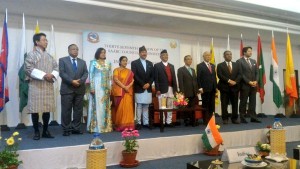POKHARA (Nepal): With South Asia being pegged as the fastest growing region in the world, India’s External Affairs Minister Sushma Swaraj stressed on the importance of accelerated connectivity in spurring the development of the SAARC region. At the 37th SAARC Council of Ministers’ meeting in Pokhara, Nepal on March 17, Mrs Swaraj said: “Connectivity is central to our development and will determine how we meet our goals of growth, employment, and prosperity. As we seek to overcome basic problems of physical connectivity, it is important for us to move forward quickly on pending agreements on rail and motor vehicles. Economic activities, cultural connections and people to people contacts will flow naturally from such connectivity.”
SAARC is the most populated region in the world comprising nearly one-fifth of the total world population. However, SAARC is the least integrated region among the major regional groups of the world. “Our region accounts for merely 2% of world trade and 1.7% of world FDI. Our intra-regional trade is less than 6% of our global trade and intra-regional FDI accounts for only 3% of total FDI inflows,” Mrs Swaraj said while underlining the gap between the potential and reality vis-à-vis SAARC.
Neighbourhood first
Underscoring the neighbourhood first mantra, India highlighted its initiatives to pursue its vision of South Asian integration. India has taken some steps to improve regional integration through initiatives such as the sub-regional cooperation between Bangladesh, Bhutan, India and Nepal, better known as the BBIN group. During the 18th SAARC summit in November 2014, Prime Minister Narendra Modi had said that regional integration in South Asia would go ahead “through SAARC or outside it, among all of us or some of us.”
Speaking about India’s commitment for the uplift of SAARC, Mrs Swaraj said: “My Government has shown its commitment to a “Neighbourhood First” policy from its very first day in office. Our vision of “Sabka saath, Sabka Vikas” is for the whole SAARC region. Together, we can create a viable ecosystem of regional integration, cooperation and socio-economic development. Together, we can unlock the latent talent of South Asia.”
India expressed its commitment to work with the SAARC community to realise the development goals of the group. Mrs Swaraj emphasised on India remaining committed to support campus and infrastructure development of the South Asian University which was set up in New Delhi exclusively for the students of SAARC countries.
Author Profile
- India Writes Network (www.indiawrites.org) is an emerging think tank and a media-publishing company focused on international affairs & the India Story. Centre for Global India Insights is the research arm of India Writes Network. To subscribe to India and the World, write to editor@indiawrites.org. A venture of TGII Media Private Limited, a leading media, publishing and consultancy company, IWN has carved a niche for balanced and exhaustive reporting and analysis of international affairs. Eminent personalities, politicians, diplomats, authors, strategy gurus and news-makers have contributed to India Writes Network, as also “India and the World,” a magazine focused on global affairs.
Latest entries
 India and the WorldNovember 26, 2025G20@20: Africa’s Moment – The Once and Future World Order
India and the WorldNovember 26, 2025G20@20: Africa’s Moment – The Once and Future World Order DiplomacyOctober 4, 2025UNGA Resolution 2758 Must Not Be Distorted, One-China Principle Brooks No Challenge
DiplomacyOctober 4, 2025UNGA Resolution 2758 Must Not Be Distorted, One-China Principle Brooks No Challenge India and the WorldJuly 26, 2025MPs, diplomats laud Operation Sindoor, call for national unity to combat Pakistan-sponsored terror
India and the WorldJuly 26, 2025MPs, diplomats laud Operation Sindoor, call for national unity to combat Pakistan-sponsored terror India and the WorldJuly 25, 2025When Fire Ends, Diplomacy Begins
India and the WorldJuly 25, 2025When Fire Ends, Diplomacy Begins








